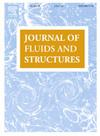双通道系统中用于增强传热的弹性片的弹跳振荡
IF 3.5
2区 工程技术
Q1 ENGINEERING, MECHANICAL
引用次数: 0
摘要
本研究探讨了利用弹性薄片作为涡流发生器(VG)来增强双通道系统中的传热。通过利用卡通振荡,夹紧在双通道共同壁上的单片材料可以同时增强两个通道的传热,同时降低压降。采用浸入式边界格玻尔兹曼方法分析了不同系统参数下的热工性能。结果表明,在给定雷诺数(Re)下,根据屈曲长度和弯曲刚度(EI*)的不同,薄板可以在卡通模式或休眠模式下工作。卡通模式具有优越的传热性能,特别是在较低的弯曲刚度下,在EI* = 0.002时,热效率系数(η)为1.3,比壁面夹紧的旗杆结构高5%,比刚性的VG结构高14.5%。对比分析表明,虽然壁面夹紧标志结构在较高的弯曲刚度下更有效,但所提出的VG在较低的弯曲刚度下表现出色,使这些结构在不同的应用中互补。通过改变板材的屈曲距离,可以进一步调节卷材的性能,η随屈曲长度的增加而减小。此外,随着Re的升高,振荡引起的流动分离加剧,进一步增强了对流换热。在Re = 1000时,η值超过1.4,在高Re状态下表现出稳健的性能。这些发现突出了VG在双通道应用中可调和高效传热增强的潜力。本文章由计算机程序翻译,如有差异,请以英文原文为准。
Snap-through oscillations of an elastic sheet for enhanced heat transfer in dual-channel systems
This study explores the use of the snap-through behavior of an elastic sheet as a vortex generator (VG) to enhance heat transfer in a dual-channel system. By leveraging snap-through oscillations, a single sheet clamped at the common wall of the dual channels can simultaneously enhance heat transfer in both channels with a reduced pressure drop. The thermohydraulic performance is analyzed using the immersed boundary-lattice Boltzmann method across varying system parameters. The results demonstrate that for a given Reynolds number (Re), the sheet can operate in either a snap-through mode or dormant mode, depending on its buckled length and bending stiffness (EI*). The snap-through mode achieves superior heat transfer performance, especially at lower bending stiffness, with a thermal efficiency factor (η) of 1.3 at EI* = 0.002, outperforming the wall-clamped flag configuration by 5% and the rigid VG by 14.5%. Comparative analysis reveals that, while the wall-clamped flag configuration is more effective at higher bending stiffness, the proposed VG excels at lower bending stiffness, making these configurations complementary across different applications. The performance of the VG can be further adjusted by modifying the buckled distance of the sheet, with η decreasing as the buckled length increases. Additionally, as Re rises, oscillation-induced flow separation intensifies, further enhancing convective heat transfer. At Re = 1000, η exceeds 1.4, demonstrating robust performance in high-Re regimes. These findings highlight the VG’s potential for tunable and efficient heat transfer enhancement in dual-channel applications.
求助全文
通过发布文献求助,成功后即可免费获取论文全文。
去求助
来源期刊

Journal of Fluids and Structures
工程技术-工程:机械
CiteScore
6.90
自引率
8.30%
发文量
173
审稿时长
65 days
期刊介绍:
The Journal of Fluids and Structures serves as a focal point and a forum for the exchange of ideas, for the many kinds of specialists and practitioners concerned with fluid–structure interactions and the dynamics of systems related thereto, in any field. One of its aims is to foster the cross–fertilization of ideas, methods and techniques in the various disciplines involved.
The journal publishes papers that present original and significant contributions on all aspects of the mechanical interactions between fluids and solids, regardless of scale.
 求助内容:
求助内容: 应助结果提醒方式:
应助结果提醒方式:


